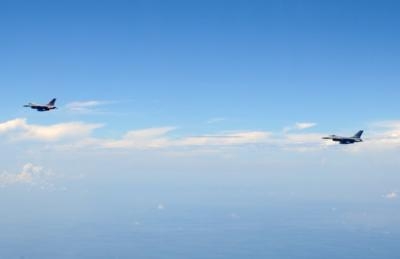Provides More Realistic Training Than Aging QF-4s
The Air Force's newest aerial target took a major step toward preparing warfighters downrange with a realistic fourth-generation replication of what they may face on the battlefield.

The first unmanned QF-16 Viper struck down over the Gulf of Mexico Sept. 5, 2014, was part of a joint effort between the Test and Training Division at Eglin Air Force Base, Florida, and the 82nd Aerial Target Squadron.
"This test was the culmination of years of planning and aircrew training specifically tailored to stand up the next generation of full-scale aerial targets," said Lt. Col. Ryan Inman, the 82nd ATRS commander. "The teamwork between members of Boeing, the systems program office at Eglin (AFB), the 53rd Weapons Evaluation Group and the 82nd ATRS enabled a nearly flawless test."
Currently, QF-4 Phantoms are used as targets to test pilots, aircraft and weapons before they reach the battlefield.
The unmanned QF-16 performed an auto-takeoff from Tyndall AFB and was targeted by air-to-air missiles launched over the gulf test range. This successful final operational test validated the QF-16's capability to assess the end game performance of weapons employed against it, and closes out the development phase of the program, according to an official at Eglin AFB's testing division.
"The aging fleet of the QF-4s and their limited capabilities against modern fighters have rendered the aerial target workhorse, Phantom II, at its technological limit," Inman said. "The QF-16 initiates the next chapter in advanced aerial targets, predominantly in support of more technologically superior air-to-air weapons test and evaluation programs. The QF-16 will enable our leaner and more efficient Air Force to continue operations at maximum mission effectiveness while maintaining air superiority and global reach for decades to come."
This test was an important step in the right direction for the program and marked the conclusion of operational and range qualification testing at both the Eglin Test Range and White Sands Missile Range.
"The successful mission is a direct result of the hard work, commitment and synergy between Air Combat Command, the Test and Training Division, the Aerospace Maintenance and Regeneration Group, the Boeing Company and numerous other stakeholders,” said Michele Hafers, the Test and Training Division director. “This test and training asset was born to fly and has flown its final mission validating our pilots and our weapons can maintain air dominance across the globe."
The 82nd ATRS is part of the 53rd Weapons Evaluation Group, 53rd Wing at Eglin AFB. The group provides the personnel and infrastructure to test and evaluate weapons utilized by the combat air forces of the U.S. and its allies. It operates the only full-scale aerial targets in the Defense Department.
In accordance with U.S. law, Title 10, Section 2366 of the U.S. Code, a missile system must undergo lethality testing before it can enter full-scale production. The 82 ATRS maintains DOD’s sole capability to execute the Title 10 requirement. There are sub-scale target capabilities in other services, but the Air Force is the only service that has a full-scale aerial target program, Inman said.
"Team Target executes that capability flawlessly every day at Tyndall and Holloman AFB," Inman said. "This test could not have been accomplished without the unparalleled support of the operations and mission support groups. From the fire and explosive ordnance disposal support, to the airfield management and tower and radar approach control support, to the logistical support, there are countless unrecognized cogs behind the successful mission. We are merely the execution agency that gets to sit at the end of the droneway and bask in the achievement."
(USAF image)
 ANN's Daily Aero-Linx (04.16.24)
ANN's Daily Aero-Linx (04.16.24) Aero-News: Quote of the Day (04.16.24)
Aero-News: Quote of the Day (04.16.24) Airborne 04.10.24: SnF24!, A50 Heritage Reveal, HeliCycle!, Montaer MC-01
Airborne 04.10.24: SnF24!, A50 Heritage Reveal, HeliCycle!, Montaer MC-01 Airborne 04.12.24: SnF24!, G100UL Is Here, Holy Micro, Plane Tags
Airborne 04.12.24: SnF24!, G100UL Is Here, Holy Micro, Plane Tags Airborne-Flight Training 04.17.24: Feds Need Controllers, Spirit Delay, Redbird
Airborne-Flight Training 04.17.24: Feds Need Controllers, Spirit Delay, Redbird



